Understanding Your OnlyFans Account Information: Privacy and Security Tips
Ever thought about how much personal information OnlyFans creators actually share on the platform? Whether you're a creator making money or a fan subscribing to content, the platform gathers a lot of data—some of which might surprise you.
With millions of users, OnlyFans is a major content-sharing platform, but that also means privacy and security risks are unavoidable. Data breaches, identity exposure, and hacking attempts could leave your personal and financial details vulnerable. Leaked content, unauthorized access, and financial fraud are just a few of the concerns that make securing your account essential.
Understanding what OnlyFans collects and how to protect yourself is the best way to stay in control.
Let’s break it down so you can keep your information safe and your account secure.
Key Takeaways
OnlyFans collects a wide range of personal and financial data, including IDs, payment details, and usage activity. Understanding what’s collected helps you make informed privacy decisions and adjust your security settings accordingly.
Protecting your account is essential—use strong, unique passwords, enable two-factor authentication, and stay alert for phishing scams to keep hackers out.
Maintaining anonymity can enhance your privacy. Using a pseudonym, prepaid cards, a VPN, and a separate email helps keep your identity secure while engaging on the platform.
What Information Does OnlyFans Collect?

OnlyFans collects a significant amount of personal and financial data to verify identities, process payments, and comply with legal requirements. Whether you're a creator or a subscriber, understanding what information is gathered can help you make informed privacy decisions.
Personal Details: Users must provide their full name, email address, phone number, and residential address during registration.
Financial Information: Creators submit bank account information for payouts, while fans enter credit or debit card details for subscriptions and purchases.
Identity Verification: To prevent fraud and ensure age compliance, creators must upload a government-issued ID and a selfie for verification.
Device & Usage Data: OnlyFans tracks IP addresses, browser details, and user activity to monitor engagement and detect suspicious behavior.
Retention Policy: Data is stored as long as necessary to meet legal obligations, process transactions, and maintain account security. Some information may remain even after an account is deleted.
Why It Matters
Knowing what OnlyFans collects allows you to take control of your privacy. By understanding how your data is used, you can adjust security settings, limit exposure, and minimize risks while using the OnlyFans platform.
Securing Your OnlyFans Account: Essential Steps
Keeping your OnlyFans account safe requires more than just a password. Cyber threats are constantly evolving, and taking a few essential security steps can help prevent hacking, fraud, and unauthorized access.
A strong password is your first line of defense. Use a long, unique password with a mix of letters, numbers, and symbols, and never reuse it across multiple sites. A password manager can help generate and store strong credentials securely.
For added protection, enable two-factor authentication (2FA). This feature requires a second verification step, such as a code sent to your phone, making it significantly harder for hackers to gain access—even if they steal your password.
Regularly check your login sessions under account settings. If you notice an unfamiliar device or location, log out of all sessions and update your password immediately to prevent unauthorized access.
Hackers also attempt to steal login details through phishing scams—fake emails or websites that mimic OnlyFans. Always log in through the official OnlyFans website, and never click on links that ask for your credentials.
Taking these precautions keeps your account secure and under your control.
Maintaining Privacy and Anonymity on OnlyFans

Keeping your identity private on OnlyFans is essential for avoiding unwanted exposure or financial risks. A few simple steps can help protect your anonymity while using the platform.
Start by using a pseudonym instead of your real name. Avoid anything linked to your other social media sites or online presence. For financial privacy, prepaid cards or virtual payment options (like Privacy.com) can keep transactions discreet.
Be cautious with metadata in photos and videos, as it can reveal your location. Before posting, use Exif Remover or disable location tracking in your phone settings. A dedicated email address and a VPN (Virtual Private Network) can further protect your privacy by keeping OnlyFans activity separate and masking your IP address.
Uploading geotagged images can expose location data, potentially allowing others to determine a user's real-life whereabouts. Removing metadata from images and videos before posting, along with using a pseudonym, helps reduce privacy risks.
Taking these precautions ensures a safer and more private experience when you access exclusive content on the platform.
Managing Your OnlyFans Profile for Privacy and Safety
Your OnlyFans profile is the first thing people see, so setting it up with privacy in mind is essential. A few simple adjustments can help keep your identity secure while maintaining a professional appearance.
Choose a profile picture carefully—avoid using one that can be traced back to your personal social media. If privacy is a concern, consider using a logo, artwork, or a cropped image that doesn’t reveal your full face.
Adjust your profile visibility settings to restrict access to subscribers only, keeping random users from viewing your content. You can also hide your activity status for added privacy.
If someone seems suspicious or makes you uncomfortable, use OnlyFans’ blocking feature to prevent them from interacting with your profile. Additionally, restricting access from specific regions can help keep your content unseen in places where you want to maintain anonymity.
These small but important changes help both creators and fans reduce risks and maintain better control over their online presence.
Payment Methods & Protecting Financial Information

OnlyFans transactions involve sensitive financial details, making it important to understand how payments and payouts work while keeping your information secure.
Fans can subscribe to access OnlyFans content using credit or debit cards, but for more privacy, prepaid cards or virtual payment options are better alternatives. OnlyFans does not accept PayPal or cryptocurrency. For discretion, charges appear as “Fenix International Limited” on bank statements, rather than explicitly stating "OnlyFans." Those looking for enhanced financial privacy may consider prepaid cards, as they can reduce traceability compared to traditional payment methods. However, some prepaid cards may still require personal details for activation, limiting complete anonymity.
Subscriptions auto-renew by default, which can lead to unexpected charges. To avoid this, check your settings and turn off auto-renew for subscriptions you don’t want to continue.
For creators, payouts are processed via direct deposit (ACH for U.S. users) or international wire transfers, taking anywhere from one to five business days. Using a separate bank account for OnlyFans earnings can add an extra layer of security.
Security Reminder
Never share payment details with anyone, and monitor your account regularly for suspicious transactions.
Identity Verification Process: How It Works and Why It’s Important
OnlyFans requires strict identity verification to prevent fraud, comply with legal regulations, and ensure a safe environment for both creators and subscribers. This process confirms that all users are 18+ and legally eligible to participate on the platform.
To get verified, creators must submit:
A government-issued ID (passport, driver’s license, or national ID).
A selfie holding the ID to confirm identity.
Additional proof of age, if required.
These verification steps help prevent underage access, identity theft, and fraudulent accounts. Many countries enforce strict regulations on age verification, particularly for platforms that allow adult content.
OnlyFans uses a third-party service to verify identity documents, including selfies. While the platform does not explicitly state whether biometric data is stored, personal information is retained as long as necessary for compliance with legal and regulatory requirements.
If verification is rejected, it’s often due to:
Blurry or unreadable documents – Use a high-quality image.
Mismatched details – Ensure your information matches your ID.
Expired ID – Submit a valid, up-to-date document.
Privacy Consideration: Can You Request Data Deletion?
Users can request data removal after closing their account, but some records may be retained for legal and fraud prevention purposes.
What to Do If Your OnlyFans Account is Compromised

A compromised OnlyFans account can lead to leaked content, financial loss, or identity theft. If something seems off—like a login attempt you don’t recognize or settings that have been changed—it’s crucial to act quickly.
The first warning signs often include unexpected login notifications, an email about a password change you didn’t request, or transactions that don’t look familiar. In some cases, accounts may be locked due to multiple failed login attempts, signaling that someone is trying to break in.
If this happens, the first step is to secure your access. Change your password immediately, making sure to choose something unique and hard to guess. If two-factor authentication (2FA) isn’t enabled yet, turn it on right away to add an extra layer of protection. Once you’ve regained control, check your email for any security alerts and review recent login activity to spot unauthorized access.
For serious breaches—like losing access entirely or noticing unauthorized payments—OnlyFans support should be contacted as soon as possible. They can help you recover your account and prevent further damage.
Staying ahead of security threats means being proactive. Avoid phishing scams, never reuse passwords from other accounts, and regularly check your security settings to keep your account locked down. The stronger your security measures, the harder it is for hackers to gain control.
Understanding OnlyFans Terms of Service
OnlyFans has strict rules that users must follow. Violating these terms can lead to account suspension, permanent bans, or legal consequences, so understanding them is essential.
The platform prohibits illegal content, non-consensual material, and intellectual property violations. Repeated violations can result in account deactivation and withheld earnings. OnlyFans also collects and stores personal and financial data for compliance, and some information may be retained even after an account is deleted for fraud prevention or legal reasons.
Users should be cautious when clicking external links, as OnlyFans does not monitor third-party content, increasing the risk of phishing scams or malware.
Ignoring the Terms of Service can cost you your account or lead to legal issues. Knowing the rules ensures a safer and more secure experience on the platform.
Interacting Safely with Other Users
OnlyFans offers direct messaging and custom content requests, but not everyone on the platform has good intentions. Knowing what information is visible to others and setting clear boundaries can help prevent scams and privacy risks.
Creators cannot see a subscriber’s real name, payment details, or personal information—only their username and messages. Fans, on the other hand, may see profile details and creator responses, depending on account settings. This limited visibility helps protect users, but it’s still important to be cautious when engaging with others.
Scammers often request free content or promise large tips without following through. To stay safe, creators should never send content before receiving payment and should establish clear rules when handling custom requests. If an offer sounds too good to be true, it probably is. Verified accounts have a blue checkmark, and users should be wary of accounts with no profile pictures, unusual messages, or suspicious links.
OnlyFans provides built-in blocking and reporting tools to help users deal with scams, harassment, or unwanted interactions. Using these features ensures a safer and more controlled experience when engaging with other OnlyFans creators.
Final Thoughts on Privacy & Security on OnlyFans

Protecting your privacy on OnlyFans isn’t just about keeping your account safe—it’s about maintaining control over your personal and financial information. From understanding what data the platform collects to securing your login details and interactions, taking proactive steps is essential.
Simple habits like using strong passwords, enabling two-factor authentication, and being cautious with messages and links can significantly reduce risks. Staying aware of OnlyFans’ policies and adjusting privacy settings ensures a safer experience whether you’re a creator or a subscriber.
Take control of your OnlyFans experience by implementing these privacy and security best practices today.
Frequently Asked Questions
What personal data does OnlyFans collect?
OnlyFans collects your name, government-issued ID, financial details, IP address, and usage activity for verification and compliance purposes. Creator accounts must also provide identity verification to receive payouts.
How can I prevent my OnlyFans account from being hacked?
Use a strong, unique password, enable two-factor authentication (2FA), and never click on suspicious links or emails.
Can I stay anonymous on OnlyFans?
Yes! Use a pseudonym, prepaid cards, a VPN, and a separate email to maintain privacy. If you post content, be mindful of metadata in images and videos, as it could reveal personal details.
How do OnlyFans payments appear on bank statements?
Transactions are listed under “Fenix International Limited” to keep purchases discreet.
What should I do if my account is compromised?
Change your password immediately, enable 2FA, check for unauthorized logins, and contact OnlyFans support for recovery assistance.

